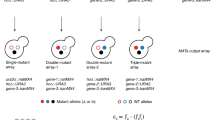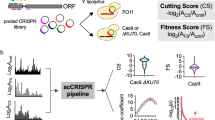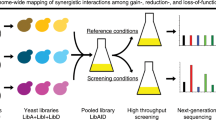Abstract
The ability to perform complex bioassays in parallel enables experiments that are otherwise impossible because of throughput and cost constraints. For example, highly parallel chemical-genetic screens using pooled collections of thousands of defined Saccharomyces cerevisiae gene deletion strains are feasible because each strain is bar-coded with unique DNA sequences. It is, however, time-consuming and expensive to individually bar-code individual strains. To provide a simple and general method of barcoding yeast collections, we built a set of donor strains, called Barcoders, with unique bar codes that can be systematically transferred to any S. cerevisiae collection. We applied this technology by generating a collection of bar-coded 'decreased abundance by mRNA perturbation' (DAmP) loss-of-function strains comprising 87.1% of all essential yeast genes. These experiments validate both the Barcoders and the DAmP strain collection as useful tools for genome-wide chemical-genetic assays.
This is a preview of subscription content, access via your institution
Access options
Subscribe to this journal
Receive 12 print issues and online access
$259.00 per year
only $21.58 per issue
Buy this article
- Purchase on Springer Link
- Instant access to full article PDF
Prices may be subject to local taxes which are calculated during checkout




Similar content being viewed by others
References
Hensel, M. et al. Simultaneous identification of bacterial virulence genes by negative selection. Science 269, 400–403 (1995).
Giaever, G. et al. Functional profiling of the Saccharomyces cerevisiae genome. Nature 418, 387–391 (2002).
Winzeler, E.A. et al. Functional characterization of the S. cerevisiae genome by gene deletion and parallel analysis. Science 285, 901–906 (1999).
Jo, W.J. et al. Identification of genes involved in the toxic response of Saccharomyces cerevisiae against iron and copper overload by parallel analysis of deletion mutants. Toxicol. Sci. 101, 140–151 (2008).
Brass, A.L. et al. Identification of host proteins required for HIV infection through a functional genomic screen. Science 319, 921–926 (2008).
Moffat, J. et al. A lentiviral RNAi library for human and mouse genes applied to an arrayed viral high-content screen. Cell 124, 1283–1298 (2006).
Mazurkiewicz, P., Tang, C.M., Boone, C. & Holden, D.W. Signature-tagged mutagenesis: barcoding mutants for genome-wide screens. Nat. Rev. Genet. 7, 929–939 (2006).
Giaever, G. et al. Chemogenomic profiling: identifying the functional interactions of small molecules in yeast. Proc. Natl. Acad. Sci. USA 101, 793–798 (2004).
Giaever, G. et al. Genomic profiling of drug sensitivities via induced haploinsufficiency. Nat. Genet. 21, 278–283 (1999).
Lum, P.Y. et al. Discovering modes of action for therapeutic compounds using a genome-wide screen of yeast heterozygotes. Cell 116, 121–137 (2004).
Shoemaker, D.D., Lashkari, D.A., Morris, D., Mittmann, M. & Davis, R.W. Quantitative phenotypic analysis of yeast deletion mutants using a highly parallel molecular bar-coding strategy. Nat. Genet. 14, 450–456 (1996).
Hillenmeyer, M.E. et al. The chemical genomic portrait of yeast: uncovering a phenotype for all genes. Science 320, 362–365 (2008).
Schuldiner, M. et al. Exploration of the function and organization of the yeast early secretory pathway through an epistatic miniarray profile. Cell 123, 507–519 (2005).
Muhlrad, D. & Parker, R. Aberrant mRNAs with extended 3′ UTRs are substrates for rapid degradation by mRNA surveillance. RNA 5, 1299–1307 (1999).
Tong, A.H. et al. Systematic genetic analysis with ordered arrays of yeast deletion mutants. Science 294, 2364–2368 (2001).
Baganz, F., Hayes, A., Marren, D., Gardner, D.C. & Oliver, S.G. Suitability of replacement markers for functional analysis studies in Saccharomyces cerevisiae. Yeast 13, 1563–1573 (1997).
Pierce, S.E., Davis, R.W., Nislow, C. & Giaever, G. Genome-wide analysis of barcoded Saccharomyces cerevisiae gene-deletion mutants in pooled cultures. Nat. Protoc. 2, 2958–2974 (2007).
Pierce, S.E. et al. A unique and universal molecular barcode array. Nat. Methods 3, 601–603 (2006).
Dwight, S.S. et al. Saccharomyces genome database (SGD) provides secondary gene annotation using the Gene Ontology (GO). Nucleic Acids Res. 30, 69–72 (2002).
Deutschbauer, A.M. et al. Mechanisms of haploinsufficiency revealed by genome-wide profiling in yeast. Genetics 169, 1915–1925 (2005).
St Onge, R.P. et al. Systematic pathway analysis using high-resolution fitness profiling of combinatorial gene deletions. Nat. Genet. 39, 199–206 (2007).
Lee, W. et al. Genome-wide requirements for resistance to functionally distinct DNA-damaging agents. PLoS Genet. 1, e24 (2005).
Gadsden, M.H., McIntosh, E.M., Game, J.C., Wilson, P.J. & Haynes, R.H. dUTP pyrophosphatase is an essential enzyme in Saccharomyces cerevisiae. EMBO J. 12, 4425–4431 (1993).
Game, J.C. Yeast cell-cycle mutant cdc21 is a temperature-sensitive thymidylate auxotroph. Mol. Gen. Genet. 146, 313–315 (1976).
Hardman, J.G., Limbird, L.E. & Gilman, A.G. (eds.) Goodman and Gilman's The Pharmacological Basis of Therapeutics 10th edn. (McGraw-Hill, New York, 2001).
Scherf, U. et al. A gene expression database for the molecular pharmacology of cancer. Nat. Genet. 24, 236–244 (2000).
Ross-Macdonald, P. et al. Large-scale analysis of the yeast genome by transposon tagging and gene disruption. Nature 402, 413–418 (1999).
Mnaimneh, S. et al. Exploration of essential gene functions via titrable promoter alleles. Cell 118, 31–44 (2004).
Sopko, R. et al. Mapping pathways and phenotypes by systematic gene overexpression. Mol. Cell 21, 319–330 (2006).
Uetz, P. et al. A comprehensive analysis of protein-protein interactions in Saccharomyces cerevisiae. Nature 403, 623–627 (2000).
Acknowledgements
We thank J. Horecka, N. Berbenetz and M. Urbanus for comments on the manuscript. This work is supported by grants from the US National Institute of Health and Canadian Institutes of Health Research to G.G. (MOP-81340) and to C.N. (MOP-84305), and from Genome Canada (to C.B. and B.J.A.).
Author information
Authors and Affiliations
Contributions
Z.Y. performed all bar-coding experiments and analysis and wrote this paper. M.C., B.J.A., J.P. and C.B. designed and created the original DAmP collection. L.E.H. did the data analysis. F.K. sequenced all bar codes. G.G. and C.N. designed the study, analyzed the data and wrote the paper.
Corresponding author
Ethics declarations
Competing interests
F.K. is employed by Prognosys Biosciences, Inc.
Supplementary information
Supplementary Text and Figures
Supplementary Figure 1, Supplementary Tables 1–5, Supplementary Methods (PDF 530 kb)
Rights and permissions
About this article
Cite this article
Yan, Z., Costanzo, M., Heisler, L. et al. Yeast Barcoders: a chemogenomic application of a universal donor-strain collection carrying bar-code identifiers. Nat Methods 5, 719–725 (2008). https://doi.org/10.1038/nmeth.1231
Received:
Accepted:
Published:
Issue Date:
DOI: https://doi.org/10.1038/nmeth.1231
This article is cited by
-
From beer to breadboards: yeast as a force for biological innovation
Genome Biology (2024)
-
Epigenetics Identifier screens reveal regulators of chromatin acylation and limited specificity of acylation antibodies
Scientific Reports (2021)
-
Quantitative CRISPR interference screens in yeast identify chemical-genetic interactions and new rules for guide RNA design
Genome Biology (2016)
-
Functional genomics to uncover drug mechanism of action
Nature Chemical Biology (2015)
-
High-throughput tetrad analysis
Nature Methods (2013)



